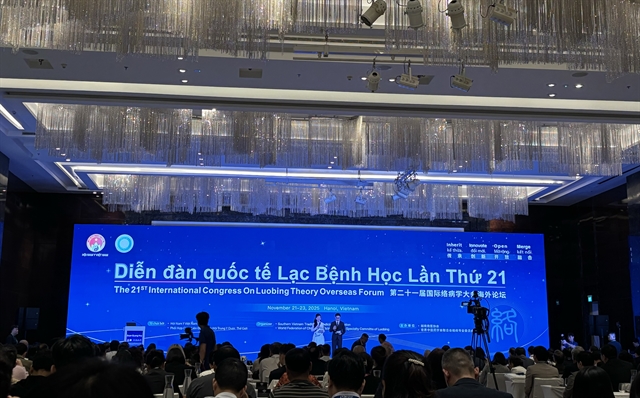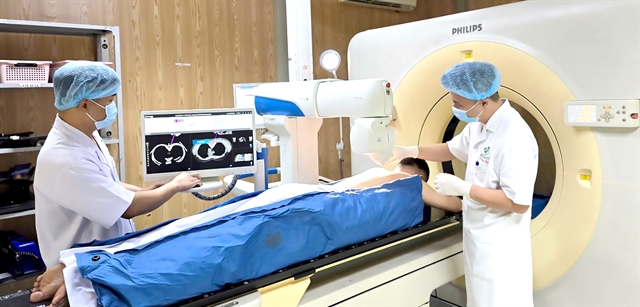 Society
Society

 |
| Since 2022, Military Hospital 175 has been equipped with the Maxio Robot system to assist in soft tissue biopsies, including for the lungs, liver and kidneys. VNA/VNS Photo Đan Phương |
By Đan Phương
HÀ NỘI — In a pioneering effort to enhance diagnostic and treatment capabilities, doctors at Military Hospital 175 have successfully repurposed the Maxio Robot, originally designed for soft tissue biopsies, for use in bone biopsy procedures.
The breakthrough was announced by the doctors, who work in the Radiotherapy Department of the hospital's Institute of Oncology and Nuclear Medicine under the Ministry of National Defence.
It offers a safer, more effective solution for diagnosing complex bone lesions that were once considered too difficult or high-risk to access.
A new frontier in bone biopsy
Bone biopsy is a critical yet highly invasive diagnostic technique used to detect malignant or unidentified bone lesions. The procedure requires exceptional precision, especially when targeting sensitive areas, such as the skull base or cervical and thoracic vertebrae. These regions are dense with blood vessels, nerves and the spinal cord. Even the slightest error during needle insertion can lead to serious complications, including paralysis, haemorrhage or death.
Since 2019, Military Hospital 175 has employed CT-guided bone biopsy techniques with promising initial results. However, these procedures relied heavily on the operator’s skill, particularly in cases involving small or deep lesions near vital anatomical structures, making accurate needle placement extremely challenging.
In 2022, the hospital acquired the Maxio Robot system, originally intended for soft tissue biopsies such as liver, lungs, adrenal glands and deep-seated lymph nodes, as well as for radiofrequency ablation treatments, per the manufacturer’s guidelines.
During routine use, however, clinicians noticed the robot’s exceptional capacity for precise targeting, CT-based needle trajectory planning and directional stability.
This observation prompted a key question from the team at the Radiotherapy Department: Could this robot also be used for bone biopsies? Despite the application falling outside the robot’s original design scope, they embarked on a rigorous research and implementation effort.
Dr Phạm Viết Hoạt, who led the initiative, explained: “Bone biopsies differ significantly from soft-tissue procedures. They require two phases: accessing the bone surface (periosteum) and then drilling through the hard bone. While the robot isn’t built to handle drilling due to high vibration, it excels at guiding and stabilising the biopsy path.”
Recognising this, the team revised the standard protocol. The Maxio Robot was used to map and stabilise the entry path to the periosteum. Once this phase was completed, the robot was disengaged and doctors manually performed the drilling and sample extraction using traditional methods. This hybrid approach successfully merged robotic precision with the manual adaptability needed for bone intervention.
Initial implementation came with challenges. The Maxio system was built for small-diameter needles compatible with soft tissue biopsies, whereas bone biopsies require thicker instruments. The research team conducted extensive trials, continually adjusting the equipment and technique to overcome incompatibility issues. Through perseverance and iterative refinements, they eventually resolved the technical hurdles and brought the innovation into routine practice.
Real-world impact
The adaptation of Maxio for bone biopsy has produced tangible clinical benefits. Thanks to accurate pre-planning and robotic stabilisation, doctors can now place needles precisely on the first attempt. This reduces the number of insertions, shortens procedure time and significantly limits radiation exposure from repeat CT scans.
Importantly, procedures once considered high-risk or nearly impossible, such as biopsies at the skull base, cervical or thoracic vertebrae are now being performed safely and successfully in hundreds of cases.
“Bone biopsy is inherently high-risk. Even a millimetre deviation can result in severe complications. Using the robot for trajectory planning eliminates the guesswork, allowing us to confidently and safely perform biopsy on tumours in difficult-to-reach areas,” Hoạt said.
The innovation is not only medically valuable, but also economically advantageous. The cost of a robot-assisted biopsy is approximately VNĐ2.5 million (around US$100), with insured patients paying less than VNĐ1 million ($38.20). Patients are discharged within 30 minutes and experience minimal discomfort.
In contrast, traditional surgical biopsies can cost over VNĐ20 million ($765), require a five-member surgical team and involve extended hospitalisation with higher risk.
By creatively adapting existing technology and integrating it into practice, the medical team at Military Hospital 175 has not only demonstrated high-level clinical expertise, but also a spirit of innovation central to modern healthcare. Their efforts contribute meaningfully to improving patient outcomes, enhancing treatment accessibility and building a forward-looking medical system.
The Maxio Robot’s use in bone biopsy stands as a vivid example of how Việt Nam is effectively implementing the Politburo's Resolution 57-NQ/TW, which emphasises the role of science, technology and innovation in advancing the healthcare sector. — VNS